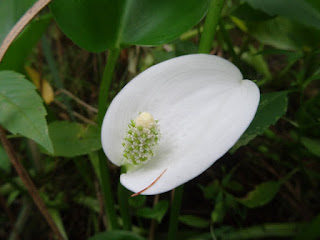The day was full of regional rarities and the morning garnered the only known population of Intermediate Pinweed (Lechea intermedia) in Waterloo. There might be 2000-3000 stems in a dry, rocky area of about 50 square metres.
Right along the rail line, at the edge of a woodland, there were several clumps of Panicled Tick Trefoil (Desmodium paniculatum). This is one of only a couple of locations in Waterloo Region where it's found. Note the elongated leaves and lighter coloured 'highlights' on the leaves, a couple of traits which differ from the more common Showy Tick Trefoil (D. canadense) which grows nearby.
I had heard a few years ago of a newly found patch of Canada Milkvetch (Astragalus canadensis) and sure enough, there among a carpet of sedges and beneath a canopy of oaks and hickories, we found 3 stems and a couple of seed pods. I think this species is more rare than a provincial rank of S4 would suggest (common and apparently secure), especially given it's affinity for dry prairie and savannah habitats. Must be doing very well somewhere.
Later in the day I was tempted to get another adventure in and decided to do some roadside botany in and around the Savannah Links Golf Course. I was tipped off that there was a historical (late 1800's) record of False Hop Sedge (Carex lupuliformis) from a pond somewhere along Cheese Factory Road. Oh if only the early naturalists had GPS units! There are several ponds along that stretch of road, some heavily grazed by cattle, others full of golfballs, and who knows maybe the sedge it still around. Until I start checking these ponds I'll continue to tear apart the perigynia of countless Hop Sedge (C. lupulina) across the province on my quest to find the achenes with massive nubs that would suggest the rare one.
I eventually found myself exploring the bog mat at Oliver's Bog. In my 20 minutes there before sunset, this spot yielded roughly 1 rarity per minute, and gave this post it's title (from the book/movie Oliver Twist).
Chokeberry (Aronia melanocarpa)
Bog Sedge or Mud Sedge (Carex limosa) which resembles Stunted Sedge (C. magellanica) but has longer staminate spikes.
Canada Rush (Juncus candensis)
The remains of Dragon's Mouth (Arethusa bulbosa). It would be a treat to come back and see these orchids in bloom.
Three-leaved Buckbean (Menyanthes trifoliata) was once valued as a cure for scurvy. The genus epithet is a mix of the greek for month 'mén' and flower 'yanthes'.
White Beakrush (Rhyncospora alba).
I had seen this a few weeks back while standing on a beaver dam near Algonquin, there were a few Bog Goldenrod (Solidago uliginosa) in bloom. The towering yellow spikes which stick up from the peat mat are hard to miss, I was about to leave and this caught my eye from 50m away.
Lastly, Wild Calla (Calla palustris), beautiful in it's simplicity.

















Hi Patrick. Is Oliver's Bog on public land? I have read about it and wanted to explore but did not want to trespass. If so where did you enter from? Or did you just view from the road and easement? Great post! Thanks
ReplyDeleteHi Jeremy, it is not public land but a road easement does run through it.
Delete